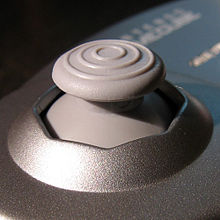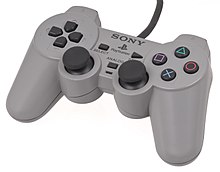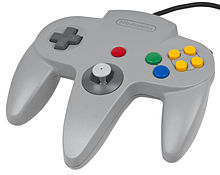| Revision as of 09:14, 15 October 2012 edit67.139.40.166 (talk) Undid revision 514403121 by Asher196 (talk)← Previous edit | Revision as of 15:29, 15 October 2012 edit undoAlphathon (talk | contribs)Extended confirmed users, Pending changes reviewers21,966 edits →Dual analog sticksNext edit → | ||
| Line 18: | Line 18: | ||
| With genres such as ], ], ], and ], the left stick normally controls the protagonist while the second stick controls the camera. The use of a second analog stick alleviated problems in many earlier platform games, in which the camera was notorious for bad positioning. The right stick not only allows for camera control in third-person platform games, but is almost essential for most modern ] such as '']'', where it controls the player's gaze and aim, as opposed to the left stick, which controls where the player moves. In Namco's '']'' and its sequels, both analog sticks are used at once to control the player's character. | With genres such as ], ], ], and ], the left stick normally controls the protagonist while the second stick controls the camera. The use of a second analog stick alleviated problems in many earlier platform games, in which the camera was notorious for bad positioning. The right stick not only allows for camera control in third-person platform games, but is almost essential for most modern ] such as '']'', where it controls the player's gaze and aim, as opposed to the left stick, which controls where the player moves. In Namco's '']'' and its sequels, both analog sticks are used at once to control the player's character. | ||
| Sony's ] has been criticized for the lack of a second analog "nub" to accompany the left-hand one,<ref>{{cite web| url=http://psp.ign.com/articles/550/550797p1.html| title=TGS 2004: Ape Escape Academics Hands-On| publisher=]| date=2004-09-24| accessdate=2007-12-14}}</ref> a criticism that was later also leveled at Nintendo's ]. Nintendo has since released an add-on for the 3DS that adds, among other things, a second analog "circle pad". The follow-up to the PSP, the ], features dual analog sticks. It is the first handheld game console to do so. |
Sony's ] has been criticized for the lack of a second analog "nub" to accompany the left-hand one,<ref>{{cite web| url=http://psp.ign.com/articles/550/550797p1.html| title=TGS 2004: Ape Escape Academics Hands-On| publisher=]| date=2004-09-24| accessdate=2007-12-14}}</ref> a criticism that was later also leveled at Nintendo's ]. Nintendo has since released an add-on for the 3DS that adds, among other things, a second analog "circle pad". The follow-up to the PSP, the ], features dual analog sticks. It is the first handheld game console to do so.<ref>http://www.gamerpops.com/2012/02/playstation-vita-impressions/</ref><ref>http://www.ign.com/blogs/jamiemad66/2012/06/10/resistance-burning-skies-review/</ref><ref>http://www.broowaha.com/articles/12859/gamechanger-or-game-ender</ref> | ||
| ==History== | ==History== | ||
Revision as of 15:29, 15 October 2012
| This article needs additional citations for verification. Please help improve this article by adding citations to reliable sources. Unsourced material may be challenged and removed. Find sources: "Analog stick" – news · newspapers · books · scholar · JSTOR (May 2010) (Learn how and when to remove this message) |

An analog stick, sometimes called a control stick or thumbstick, is an input device for a controller (often a game controller) that is used for two-dimensional input. An analog stick is a variation of a joystick, consisting of a protrusion from the controller; input is based on the position of this protrusion in relation to the default "center" position. While digital sticks rely on single electrical connections for movement (using internal digital electrical contacts for up, down, left and right), analog sticks use continuous electrical activity running through potentiometers. The analog stick has greatly overtaken the D-pad in both prominence and usage in console video games.
Usage in video games
In a video game, an analog stick is often used to move some game object, usually the protagonist. It may also be used to rotate the camera, usually around the protagonist. The analog stick can serve a great variety of other functions, depending on the game. Today many analog sticks can also be pushed like other buttons on a controller.
Its use is prevalent in 3D games, where more than 8 directions are needed (which is all that was offered on the d-pad). Using a D-pad in a 3D game greatly limits the ability to move. For example, in a 3D platform game like Super Mario 64, using a D-pad would allow Mario to move forward, left, and forward-left, but nothing in between. Some early 3D games such as Resident Evil overcame this limitation by assigning the Left and Right directions on the D-pad to spin the character instead of making the character move in that direction. This however created its own problems as the character was unable to move while spinning, requiring the player to stand in the same spot while changing direction. With the prevalence of analog sticks, the aforementioned limitations of the D-pad ceased to be an issue.
Dual analog sticks

Two analog sticks offer greater functionality than a single stick. On some modern game controllers, the position of the first stick is where the left thumb usually rests, usually to the upper left of the D-pad while the right stick is usually to the lower left of the face buttons. First-party controllers with this configuration include the Nintendo GameCube controller, Xbox controller, and Xbox 360 controller.
Some controllers instead have the two analog sticks in a symmetrical configuration with a D-pad on the left thumb position and face buttons at the right thumb position, with analog sticks below and closer to the center on both sides. Sony's PlayStation-series analog controllers—the Dual Analog Controller, DualShock, DualShock 2, Sixaxis, and DualShock 3—all use this configuration, with the remainder of the controller layout closely resembling the original digital PlayStation controller. The Classic Controller for the Wii uses this configuration, The original configuration of the Wii U touchscreen controller had twin analog "Circle Pads" positioned symmetrically above the D-pad and face buttons, but was reconfigured to have twin clickable analog sticks in May 2012.
With genres such as action, adventure game, platforming, and shooting, the left stick normally controls the protagonist while the second stick controls the camera. The use of a second analog stick alleviated problems in many earlier platform games, in which the camera was notorious for bad positioning. The right stick not only allows for camera control in third-person platform games, but is almost essential for most modern first-person shooters such as Halo, where it controls the player's gaze and aim, as opposed to the left stick, which controls where the player moves. In Namco's Katamari Damacy and its sequels, both analog sticks are used at once to control the player's character.
Sony's PSP has been criticized for the lack of a second analog "nub" to accompany the left-hand one, a criticism that was later also leveled at Nintendo's 3DS. Nintendo has since released an add-on for the 3DS that adds, among other things, a second analog "circle pad". The follow-up to the PSP, the PlayStation Vita, features dual analog sticks. It is the first handheld game console to do so.
History
The first consumer games console which had analog joysticks was the Prinztronic/Acetronic/Interton series, launched in 1976. This system was widely cloned throughout Europe and available under several brand names. The 2 sticks each used a pair of potentiometers, but were not self-centering.
In 1982, Atari released their first controller with a potentiometer-based analog joystick for their Atari 5200 home console. However, its non-centering joystick design proved to be ungainly and unreliable, alienating many consumers at the time. During that same year, General Consumer Electronics introduced the Vectrex, a vector graphics based system which used a self-centering analog stick, a precursor to the modern design. For many years, consoles ignored analog technology, instead using the digital d-pad. It was not until the emergence of 3D graphics, and the gameplay mechanics that came along with it, that the analog stick was brought back for widespread use.
In 1985, Sega's third-person rail shooter game Space Harrier, released for the arcades, introduced a true analog flight stick for movement. It could register movement in any direction as well as measure the degree of push, which could move the player character at different speeds depending on how far the joystick is pushed in a certain direction.
On April 26, 1996, Sony released a potentiometer-based analog joystick for use in Flight-Simulation games. The Sony Dual Analog FlightStick featured twin analog sticks and was used in games such as Descent to provide a much greater degree of freedom than the typical digital joysticks of the day.

Initially announced for release on April 21, 1996, Nintendo released their Nintendo 64 controller on June 24, 1996. The new controller included a thumb-operated control stick which, while a digital stick (the stick operated on the same principles as a mechanical computer mouse), still allowed for varying levels of movement and near-360-degree control, translating into far more precise movements than were possible with a D-pad.
On July 5, 1996, Sega released Nights into Dreams... for their Saturn console in Japan; bundled with it was the Saturn 3D control pad which featured an analog pad intended to give the player more fluid control over that game's flight-based gameplay. The analog pad was less complex in construction in comparison with its contemporaries due to the implementation of Hall Effect sensors, serving as a basis for the Dreamcast controller.
On April 25, 1997, Sony released a similar analog stick, based on the same potentiometer technology that was used in the larger Dual Analog Flightstick. The Sony Dual Analog controller featured rumble, three modes of analog (Flightstick, Full Analog and Analog-Off), and dual plastic concave thumbsticks, while Nintendo and Sega's controllers only had a single stick.
On November 20, 1997, Sony released their third analog controller to the market: the DualShock. The controller featured similar twin analog sticks to the Dual Analog, although they featured convex rubber tips rather than concave plastic ones. Sony also removed the third analog (flightstick) mode and added two new buttons, L3 and R3, under the thumbsticks, which could be used by pressing down on the sticks.
In 1999, Sony's Ape Escape became the first major video game to require the use of two analog sticks.
In the console generations that followed, many video game console controllers have included two analog sticks, with the exception of the Dreamcast and Nintendo's non-classic Wii controllers. Other exceptions to this dual-stick rule are Sony's PlayStation Portable and Nintendo's 3DS handheld game consoles (although the latter may be upgraded to dual-stick functionality through the use of an accessory), which both feature only a single small, flat sliding analog "nub". However, Sony's PlayStation Vita does have a dual analog stick configuration.
See also
References
- http://e3.nintendo.com/hw/#/about
- "TGS 2004: Ape Escape Academics Hands-On". IGN. 2004-09-24. Retrieved 2007-12-14.
- http://www.gamerpops.com/2012/02/playstation-vita-impressions/
- http://www.ign.com/blogs/jamiemad66/2012/06/10/resistance-burning-skies-review/
- http://www.broowaha.com/articles/12859/gamechanger-or-game-ender
- Space Harrier Retrospective, IGN
- ^ "SCPH". maru-chang.org.
- http://www.gamezero.com/team-0/articles/industry/shoshinkai_1995/nu64-1.html
- http://www.1up.com/do/feature?pager.offset=3&cId=3143627
- "Sega Saturn 3D Pad - What's inside?". NFG. 2008-10-20. Retrieved 2011-09-14.
External links
How Stuff Works articles on:
Category: